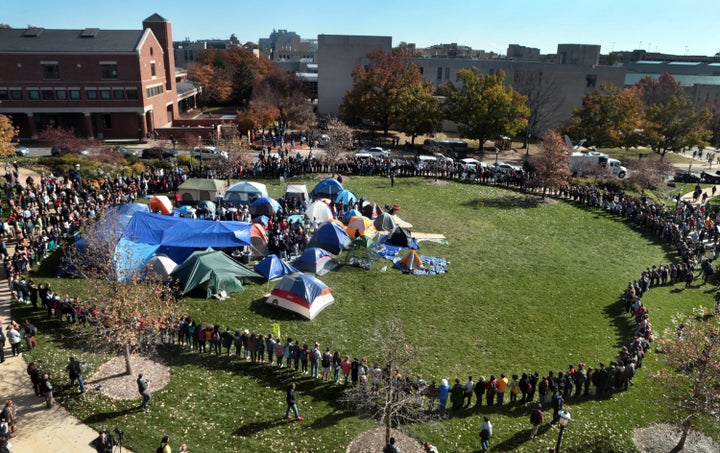A clash between University of Missouri journalists, staff and students Monday is a crucible for discussions about First Amendment rights in the United States. Now that so many American adults carry around smartphones that can capture and disseminate photos and videos instantly, ethical decisions that once were the sole responsibility of editors, reporters and correspondents are in everyone's hands.
Tim Tai, a freelance photojournalist on assignment from ESPN tried to take pictures of an area at the university where students were protesting racism. In doing so, he has ended up being at the center of the story, despite his wish to be otherwise.
As Tai pointed out on Twitter, a new Missouri law made college campuses public forums this year, which gave these protests First Amendment protections. The law also means that the public, press and students all have First Amendment rights on that quad. Students have the right to freedom of expression. Media have the right to cover what's happening in the public space. A “media-free zone” that the protesters designated on the campus quad is unconstitutional. University staff that encourage blocking media engaged in inexcusable behavior toward journalists.
Here's video of the encounter between Tai and protesters:
A day after the clash, there's been welcome shift: The student activists have adjusted their stance towards media access, calling the incident a "teachable moment" and handing out public service announcements regarding the First Amendment.
Given the irresponsible, negative ways that #BlackLivesMatter activists have been portrayed in the media this fall, it's not hard to see why these college students would have been suspicious or even actively hostile to national media coverage.
We can't simply divorce the history of how U.S. media have depicted minorities from the distrust of college activists today. Consider, for instance, how differently U.S. media has portrayed white suspects in shootings and black victims.
As technology entrepreneur and blogger Anil Dash pointed out on Twitter, the ethics code from the Society for Professional Journalists includes a section on minimizing potential harms to the subjects of stories, not just sources.
Last year, Dash wrote a post about what being "public" means to him, arguing that technology companies, media companies and the public all need to take a step back from how public is being defined and by whom:
Public is not just what can be viewed by others, but a fragile set of social conventions about what behaviors are acceptable and appropriate. There are people determined to profit from expanding and redefining what’s public, working to treat nearly everything we say or do as a public work they can exploit.
I don't agree with everything Dash wrote, but the entire post is worth reading.
From my perspective, journalists need to be able to be present at public protests in public spaces to bear witness, but that doesn't mean that they must publish everything they see or hear. Now that 68 percent of Americans use smartphones, we also share a responsibility to respect the privacy of others.
Publishing a photo or video online should not only have public interest value but balance potential harms against the long-term consequences of recording and publishing.
I hope that in the days and month to come, students, staff and faculty at more universities around the country find ways to support both sides of that equation.

